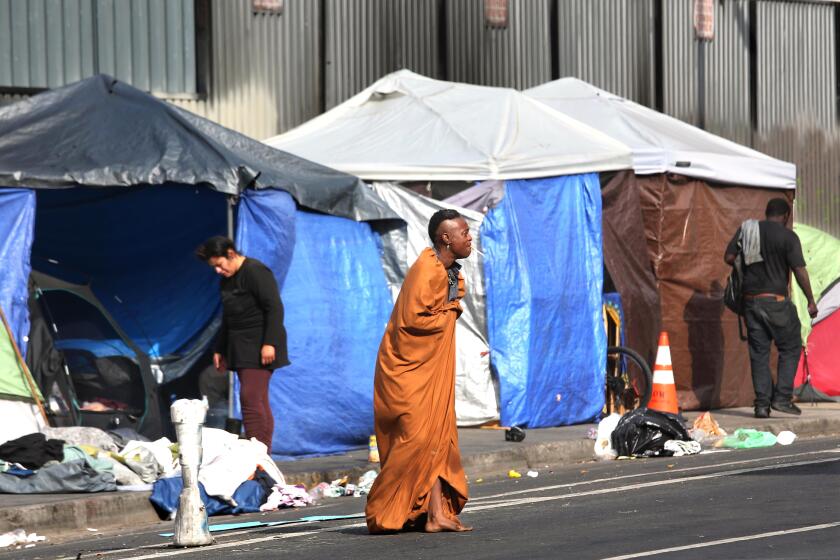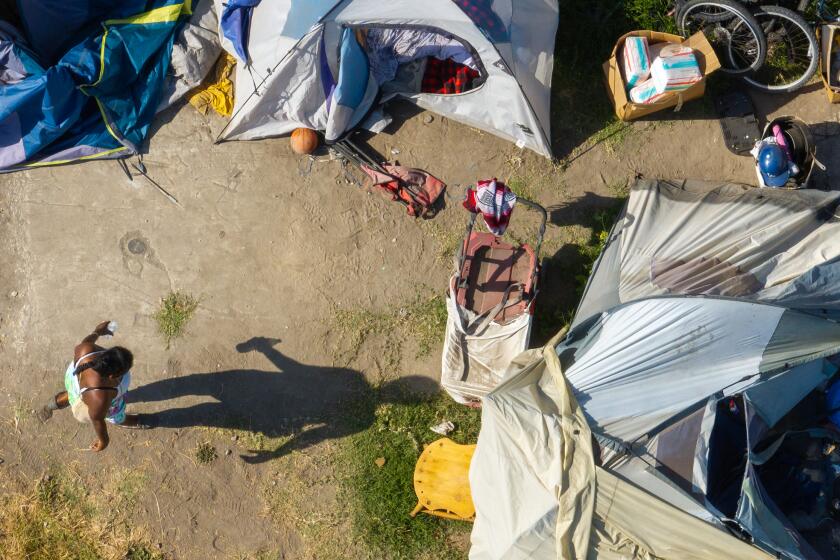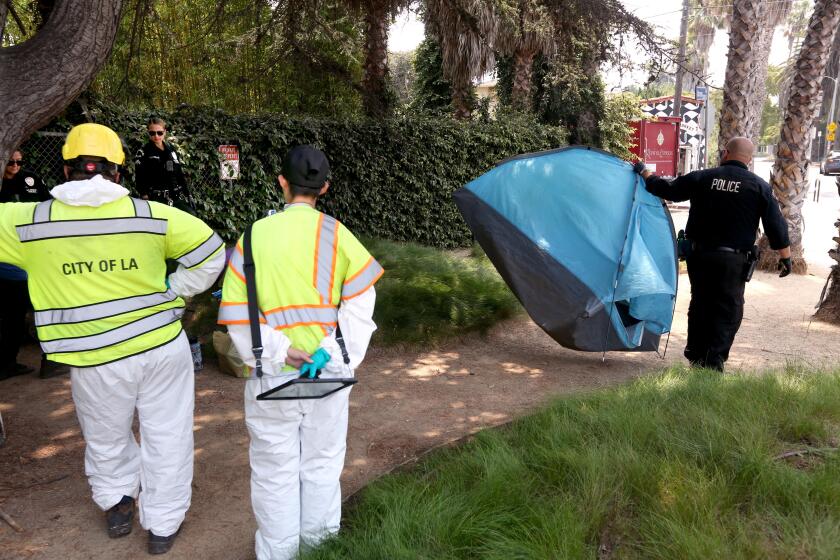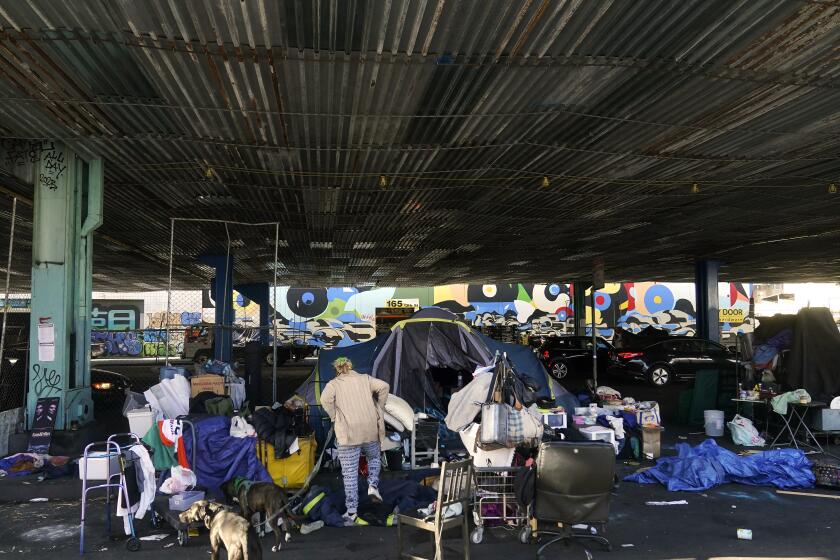Opinion: Gov. Gavin Newsom is a reactionary on homelessness — and that’s a good thing
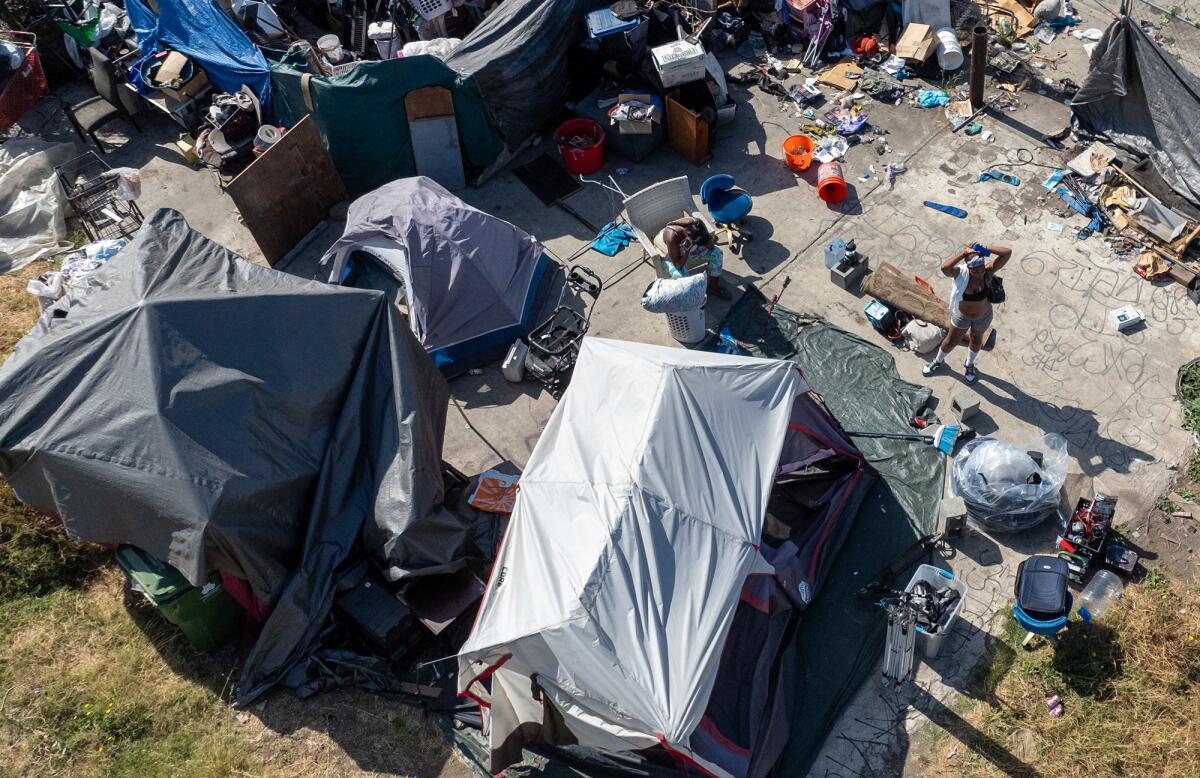
- Share via
Confused? California’s uber-progressive governor, Gavin Newsom, ordered state agencies to forcibly clear homeless camps in their jurisdictions and is cajoling cities and towns to follow suit, with state funds.
Homeless advocates are outraged. The group Housing Is a Human Right called it “strange” that the liberal governor would take such a “heartless” and “ultra-conservative” hardline approach.
But for anyone paying attention, the governor’s move should be totally expected — Newsom has been tough on homelessness for decades and bent on undoing Ronald Reagan’s failed legacy. Let’s hope he succeeds.
Gov. Gavin Newsom issues an executive order requiring state agencies to remove homeless encampments in their jurisdictions and urging California’s cities to follow suit.
It sounds made up but it’s true: San Francisco pays “general assistance” cash to some of its homeless residents. In the early 2000s, news reports brimmed with stories of the unhoused using their taxpayer funds on drugs and alcohol.
As a young San Francisco supervisor, Newsom successfully pushed an overhaul to the system via a local ballot measure called Care Not Cash. It passed with 60% of the votes, promising to cut general assistance and use the savings to deliver shelter beds and wrap-around services. Newsom rode his reputation as a serious, bold thinker all the way to the state’s highest office.
By 2009, the city’s overall homeless population had dropped by 25%, with chronic homelessness plummeting by 72%, at least officially. But today, both types of homelessness in the City by the Bay are only a fraction below levels seen in the early 2000s.
And of course San Francisco’s problem has metastasized across the state and region amid rising housing costs, mass jail and prison releases, more powerful opioids, and the increase in pandemic-related social isolation and addiction and mental health problems.
Gov. Gavin Newsom urges counties to expand conservatorship laws to combat homelessness, other crises
A new state law makes it easier to appoint a conservator to direct care of people suffering from mental illness or substance abuse to prevent further crisis.
The situation is as visible as it is intractable. In 2019, the 9th U.S. Circuit Court of Appeals’ Martin vs. Boise decision effectively legalized public camping in the nine western states if there weren’t enough shelter beds to house the homeless population.
But last month, a reconfigured Supreme Court upended Martin vs. Boise when it allowed Grants Pass, a small Oregon town, to ban public camping, with fines and potential jail time.
Fewer camps and more consequences would be a good thing. What we really need is more asylums. But they are almost all shuttered — and that’s partly Ronald Reagan’s fault.
Critics worry that cities will lean into criminalizing and further marginalizing unhoused people, worsening the crisis.
And Gavin Newsom is poised to fix it.
In the 1960s, public opinion turned against involuntary commitments and the abuses of “snakepit” asylums. California’s social engineers led a push for “deinstitutionalization” — moving psychiatric inpatients into outpatient care and the cash-strapped state budget out of the red.
In 1967, fellow Republicans persuaded then-Gov. Reagan to sign the landmark Lanterman-Petris-Short Act. It seemed to be a win all around — bestowing freedom on the confined, self-satisfaction to the social engineers and taxpayers a free lunch.
Within five years, California’s asylum population dropped by nearly 70% — and by nearly 85% after 25 years. Deinstitutionalization fever infected state capitals across the country. In Massachusetts, inpatient psychiatric beds dropped by 90% from 1953 to 1980. In 1950, mental hospitals held 1 in 3,500 Americans, dropping to 1 in 700 in 1970 and 1 in 3,000 by 1980. Today there are only about 36,000 inpatients in state psychiatric wards — or 1 in 10,000.
The California State Auditor’s Office analyzed homelessness spending at the behest of lawmakers concerned about efficacy.
As politicians closed the mental hospitals willingly, the Supreme Court bestowed previously unknown “rights” on the mentally ill in a series of surreal decisions. In 1975, a unanimous court wrote: “May the State fence in the harmless mentally ill solely to save its citizens from exposure to those whose ways are different?” And likened involuntary commitment to locking up the “physically unattractive or socially eccentric” to avoid “public unease.”
Meanwhile, penny-pinching politicians were slow to fund the community clinics and the outpatient care that was supposed to accompany deinstitutionalization. Streets and jails quickly became America’s new asylums.
Although mental illness isn’t the only cause of burgeoning homeless encampments, as the journal Psychiatric Times noted in 2020, “There is clearly a link. … Mental illness had preceded homelessness in about two-thirds of the cases.” A Los Angeles Times analysis in 2019 showed that nearly 70% of the county’s homeless population was mentally ill or drug addicted. A 2022 UC San Francisco survey of California’s homeless found that 82% self-reported a mental health condition with 66% experiencing symptoms recently.
Three new studies shed new light on homelessness in Los Angeles, painting a mostly grim picture, with some glimmers of hope.
The Golden State has spent (and barely tracked) more than $24 billion since 2018 on homelessness services, including mental health and substance abuse treatment. But the UCSF study showed that only 14% of California’s mentally ill unhoused received outpatient care and only 20% received medication.
Vexed by the crisis, Newsom has been battling to reform the state’s byzantine and lenient conservator laws and for the creation of court-mandated outpatient treatment plans, or CARE Courts.
But in the last year, the governor went even further, showing himself to be a radical reformer — or reactionary. First, he pushed a bond measure that passed in March that builds, yes, asylums. The narrowly passed ballot measure seeks to build facilities with beds for 10,000 patients and provide four times that many outpatients treatment slots.
San Francisco Mayor London Breed said the city will start aggressively clearing homeless camps in August, following a U.S. Supreme Court ruling that gives cities greater authority to move people off the streets.
Second, he gutted the 1967 law signed by Reagan that flung open the asylum doors. The Newsom-backed changes empowered qualified third parties — mental health professionals — to impose a conservatorship on an individual suffering from a substance abuse or mental health disorder, if their condition places them at “substantial risk of serious harm.”
California’s emerging about-face will certainly face legal challenges based on the inane Supreme Court precedents of the 1970s. Still, it represents commonsense progress on a stubborn part of the homelessness problem, and Newsom deserves credit.
Whether or not we involuntarily commit and treat the mentally ill and addicted raises existential questions about free will, dignity and individual autonomy. As a practical and moral matter though, how does abetting utter misery in our streets make us enlightened beings or our communities more livable for us or them?
Sean Kennedy is the executive director at the Coalition for Law, Order, and Safety, a think tank in Alexandria, Va., and a fellow at the Maryland Public Policy Institute.
